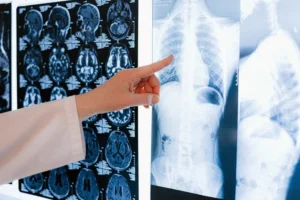How is Acromegaly Treated?
- Updated on: Jan 28, 2020
- 5 min Read
- Published on Jan 28, 2020

Acromegaly is a chronic disease characterized by increased secretion of growth hormone (GH) and consequently insulin-like growth factor-I hypersecretion causing development of cardiovascular, respiratory, metabolic, skeletal and neoplastic complications with significant impact on patient’s quality of life.
Acromegaly treatment aims at normalizing GH and IGF-I hypersecretion, controlling tumor growth, improving symptoms and comorbidities and decreasing mortality.
Common treatment methods for acromegaly are as follows.
Surgical Therapy
The operative treatment of pituitary adenomas causing acromegaly is a widely accepted first line standard therapy that involves removing the pituitary tumor that’s making too much growth hormone (GH).
The procedure is used to reduce the size of the pituitary tumor in someone with acromegaly and also in reducing the excess growth of hormone levels.
Key points regarding surgical therapy for acromegaly are:
- Cure rates are about 80% and 40% for microadenoms and macroadenomas respectively
- Transsphenoidal selective adenomectomy is a type of procedure for the removal of pituitary tumor and is the procedure of choice
- Outcome of the surgery is highly dependent on the skills and experience of the neurosurgeon
- The procedure is safe with low morbidity and mortality
Goals of Surgery to Treat Acromegaly
The objectives of an acromegaly surgery are:
- Removing the pituitary tumor secreting too much GH should alleviate the effects and symptoms of acromegaly because the body produces a normal amount of GH after the surgery. Getting GH and insulin-like growth factor-1 (IGF-1) back into acceptable ranges is the number one goal of surgery.
- Relief from associated symptoms such as headaches is another important goal of the surgery. The tumor presses a certain part of the brain causing pain. Removing the tumor should alleviate those headaches.
- Preventing the tumor from growing back so that it doesn’t recur and again cause excessive growth hormone in the body.
Pharmacological Therapy
Pharmacological therapy is mainly indicated when surgery fails to achieve remission but is increasingly considered as primary medical treatment. The three classes of drugs are currently available for the treatment of acromegaly are SRLs, GH receptor antagonists, and dopamine agonists.
Somatostatin Receptor Ligands
SRLs are analogues of natural somatostatin and exert their effects by binding to somatostatin receptors (SSTRs) on pituitary somatotrope cells, thus suppressing GH secretion. Commercially available drugs include octreotide and lanreotide. Long-acting preparations have been developed for both molecules, increasing patient comfort and compliance.
Key benefits of SRLs:
- Success rate about 45%–65%
- It is very effective as a first line therapy
- Parenteral route of administration
- Tumour shrinkage occurs in about 30% of cases
Growth Hormone Receptor Antagonist
Growth hormone receptor antagonist is a genetically engineered analogue of human growth hormone that acts as a growth hormone receptor antagonist. It is a new form of treatment with promising efficacy in the management of acromegaly.
The growth hormone molecule has two binding sites by which it binds to two identical cell surface receptor molecules, causing dimerisation and receptor activation leading to intracellular signaling and IGF-1 production.
Key benefits and limitations of growth hormone receptor antagonists:
- 97% of patients achieve normal IGF-1 levels
- Growth hormone levels remain high
- It is not yet available for commercial use
Dopamine Agonists
Dopamine agonists have been used for the management of acromegaly for more than 30 years but low efficacy has discouraged their adoption as monotherapy. Bromocriptine and Cabergoline are the dopamine agonists used with limited effect in the treatment of acromegaly.
Key benefits and limitations of dopamine agonists:
- Effective in tumours with positive growth hormone plus prolactin immunostaining
- Oral route of administration and low cost
- Less effective compared with other treatments
Radiation Therapy for Treating Acromegaly
Radiation therapy provides a useful third line therapy for acromegaly where surgery and medical therapy are unable to achieve adequate hormonal response. The introduction of radiation therapy has further increased the therapeutic options available in the management of acromegaly.
Different Types of Radiation Therapies
Your doctor may choose one or more of the many types of radiation therapy procedures for treating acromegaly.
Conventional radiation therapy
This type of radiation therapy is usually given every weekday over a period of four to six weeks. With the introduction of new medical treatments, it is now mainly used as an adjuvant treatment and in patients unsuitable for surgery.
The two main disadvantages of the conventional radiation therapy are prolonged delay in achieving target growth hormone levels and high incidence of hypopituitarism. Tumor growth is prevented in more than 99% of cases.
Proton beam therapy
Proton beam therapy delivers a targeted, high dose of radiation to the tumor, sparing radiation exposure to normal tissues. The main issue with this type of radiotherapy is that the safe dose which can be administered is limited by the radiation toxicity capacity of healthy tissues adjacent to the target tumor.
Stereotactic radiosurgery
Stereotactic radiosurgery delivers a high dose of radiation to tumor cells in a single dose while limiting the amount of radiation to normal surrounding tissues. It is especially useful for tumors invading the cavernous sinuses where the cranial nerves are much less susceptible to damage from radiation than the optic nerves.
This type of radiation therapy brings GH levels back to normal within five years.
Control of Comorbidities via Biochemical Control of Acromegaly
In addition to medical therapy for GH/IGF-I hypersecretion, treatment of comorbidities has an important impact on quality of life and mortality. There are a number of comorbidities that are present in patients with acromegaly such as arthropathy, hypertension, obstructive sleep apnea (OSA), diabetes, cardiomyopathy, colon polyps, goiter, and headache.
The successful treatment of GH/IGF-I hypersecretion can control these comorbidities to varying degrees, but some of them may persist in patients even after biochemical control of acromegaly. All comorbidities should be actively diagnosed and treated, irrespective of GH and IGF-I control.
Frequently Asked Questions:
1. What is the life expectancy of someone with acromegaly?
Life expectancy of someone with acromegaly can be reduced by approximately 10 years, especially when their growth hormone levels are uncontrolled and diabetes and heart disease are present. Patients who are successfully treated for acromegaly and whose growth hormone and IGF-1 levels fall to normal generally have a normal life expectancy.
2. What happens if acromegaly goes untreated?
If acromegaly is left untreated, our body will produce too much growth hormone that can lead to various complications.
The most common acromegaly complications are:
- Soft Tissue Complications
- Pituitary Hormone Deficiencies
- Respiratory problems
- Sleep Apnea
- Heart Problems
- Diabetes
Early treatment can prevent these complications from developing or becoming worse. If acromegaly is left untreated, these complications can lead to premature death.
3. Is acromegaly painful?
Musculoskeletal pain is a frequent problem encountered in acromegaly patients and is associated with a reduction in quality of life. Joint symptoms are the most frequent complaints affecting approximately 70% of individuals at the time of diagnosis. Due to the enlargement of different parts of the body, acromegaly often causes the bones and cartilages to grow too much, making it painful to move.
4. Is acromegaly reversible?
There are certain features of acromegaly which may not be reversible. Examples of these are where acromegaly has developed over a period of time and there have been changes in the shape of bones and particularly of development of other features typical of acromegaly such as high blood pressure, diabetes or arthritis. Other problems that affect the quality of life of people with acromegaly include arthritis, which can be progressive. The fact that there is a possible increased risk of heart disease and sometimes bowel tumors, the condition may further affect quality of life. Because of these problems, patients who have had acromegaly need regular screening for possible bowel tumors and heart diseases.
5. Is acromegaly inherited?
Usually acromegaly is not inherited. Acromegaly is inherited in a very rare condition called ‘familial isolated pituitary adenoma’ or as part of multiple endocrine neoplasia type 1. If someone has the gene for this condition, they are more likely to develop the pituitary tumor and release excess growth hormone when they are teenagers, rather than when they are older. As a teenager, the extra growth hormone makes patients very tall because it occurs when the bones are still able to grow.












